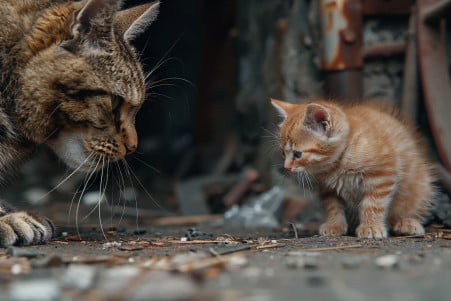Do Cats Kill Each Other? What to Know About Feline Aggression
7 May 2024 • Updated 6 May 2024

Although cats are often considered solitary animals, the idea of one cat killing another in a home environment is a real concern for cat owners. In fact, cats can and do kill each other through predatory aggression and competition for resources, including food, territory, and mating opportunities, especially in the case of unneutered males. However, with the right precautions, such as early neutering and careful introductions, these situations can often be avoided.
In this article, we'll explore the research of animal behaviorists and veterinarians who have looked at the factors that contribute to cat-on-cat aggression and even death. This includes research on territorial behavior, social structures in feral cat colonies, and the role of hormones and the desire to reproduce. This research has helped to identify the causes of aggressive behavior and how pet owners can avoid the worst-case scenario. By understanding the causes of aggression in cats, you can ensure a more peaceful multi-cat home.
Do Cats Kill Each Other?
Common Causes of Aggression in Cats
There are many reasons why a cat may become aggressive. Some of the most common causes of aggression in cats include:
- Play Aggression: This is a type of aggression that is often seen in kittens and young cats. It occurs when a cat becomes overstimulated during play and starts to bite or scratch. This type of aggression is often due to a lack of socialization and can be avoided with proper training.
- Fear Aggression: This type of aggression occurs when a cat feels threatened. It can be due to a lack of socialization or past traumatic experiences. When a cat is afraid, they may lash out in an attempt to protect themselves.
- Petting-Induced Aggression: This type of aggression occurs when a cat becomes overstimulated during petting. It is often due to a lack of socialization and can be avoided with proper training.
- Redirected Aggression: This type of aggression occurs when a cat is unable to direct their aggression at the source of their frustration. For example, if a cat sees another cat outside and becomes frustrated but can't get to the other cat, they may redirect their aggression at another cat in the household.
- Pain-Induced Aggression: This type of aggression occurs when a cat is in pain. When a cat is in pain, they may lash out at anyone who tries to touch them or pick them up.
- Status-Induced Aggression: This type of aggression occurs when a cat feels the need to assert their dominance over another cat. It is often seen in multi-cat households and can be avoided with proper training.
- Territorial Aggression: This type of aggression occurs when a cat feels the need to protect their territory from another cat. It is often seen in multi-cat households and can be avoided with proper training.
- Maternal Aggression: This type of aggression occurs when a mother cat feels the need to protect her kittens from a perceived threat. It is often seen in multi-cat households and can be avoided with proper training.
- Inter-Cat Aggression: This type of aggression occurs when a cat feels the need to assert their dominance over another cat. It is often seen in multi-cat households and can be avoided with proper training.
While these are some of the most common causes of aggression in cats, it's important to note that aggression is a complex issue and can be caused by a variety of biological, environmental, and social factors. It is not an inherent part of a cat's personality. Understanding the causes of aggression in cats is important because it can help you manage and treat aggressive behaviors more effectively.
Lethal Aggression in Feral and Wild Cat Populations
In the wild, cats are solitary hunters and tend to avoid aggression that could result in injury or death. That said, a study of feral cats found that territorial disputes, competition for mates, and protecting offspring can lead to lethal aggression in feral or wild cat populations. Male cats, especially those that have not been neutered, are more likely to be involved in aggression during mating season or when it comes to protecting their territory.
While the likelihood of severe injury or death is relatively low, bacteria in cats' mouths and claws can cause life-threatening infections if wounds are not treated. As a result, feral cat colonies and urban populations of cats are more likely to experience lethal aggression due to competition for resources and space.
Potential Risks and Dangers of Cat Fights
Although most cat fights are relatively harmless and don't involve physical contact, when cats do fight, the physical contact can lead to some pretty serious issues. VCA Animal Hospitals explains that the most common injuries that cats sustain from fighting are puncture wounds from bites or scratches. These wounds are especially prone to infection because of the bacteria that's found in cats' mouths.
If left untreated, bite wounds and abscesses can lead to a number of complications, including joint or bone infections, fever, limping, and in severe cases, sepsis. The South Seattle Veterinary Clinic also explains that cat bites are the most common way that cats spread infectious diseases, including Feline Immunodeficiency Virus (FIV) and Feline Leukemia Virus (FeLV).
Although fatalities are rare, Catster explains that they can happen as a result of severe blood loss, internal injuries, or infections from untreated wounds. That said, it's important to note that with proper care, most cats will recover from their injuries.
How to Avoid and Deal With Aggression in Multi-Cat Households
Proper socialization and slow introductions are important when bringing new cats into a home and can help prevent territorial aggression, according to the ASPCA. Making sure that there are plenty of resources available, including food, water, litter boxes, and vertical territory, can help reduce competition and aggression between cats, according to the Merck Veterinary Manual.
Environmental enrichment, such as scratching posts, toys, and hiding places, can help reduce stress and aggression, according to Clinicians Brief. In addition, using pheromone products and training cats to come when called can help redirect their focus and reinforce positive behaviors. In cases of more serious aggression, the Merck Veterinary Manual recommends separating the cats and consulting a veterinary behaviorist.
With good management practices, pet parents can help reduce the likelihood of aggression and ensure that their multi-cat household is a happy one. However, it's also important to understand the reasons behind lethal feline aggression so that you can work to prevent the worst outcomes.
Factors That Contribute to Lethal Cat Aggression
Lethal aggression between cats is rare but can be influenced by a number of biological, social, and environmental factors. The Merck Veterinary Manual explains that territorial disputes and competition for resources are common causes of aggression and that unneutered males are the most likely to be involved in violent interactions.
In addition, maternal aggression and the desire to protect their young can lead female cats to engage in lethal aggression against other cats. Hepper explains that a lack of socialization, past traumas, and medical issues can make cats more fearful and aggressive.
Environmental factors, such as changes in the home or overcrowding, can also make cats more likely to be aggressive and to engage in lethal aggression, as Best Friends Animal Society points out. Understanding these factors is important for preventing and addressing the potential for lethal aggression between cats.
Conclusion: How to Prevent and Manage Aggression in Multi-Cat Households
Although lethal aggression is uncommon, it is a serious issue that pet parents should take steps to prevent. Knowing the different types of aggression, what can cause them, and what can happen as a result is important for preventing and dealing with aggression. Proper socialization, slow introductions, resource control, and environmental enrichment are all important for preventing aggression in multi-cat homes.
If aggression is happening, it may be necessary to work with a veterinary behaviorist and separate the cats. However, with a focus on their cats' well-being and a little bit of planning, pet parents can reduce the risk of lethal aggression and help their cats live together safely and happily.


